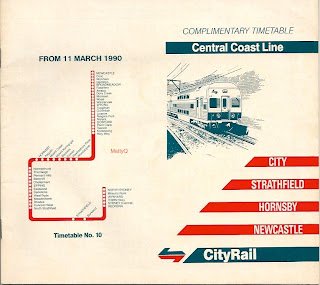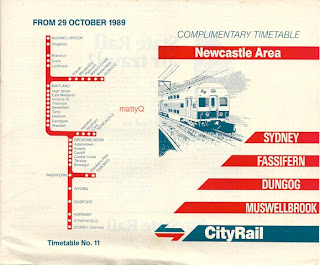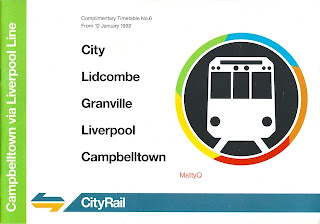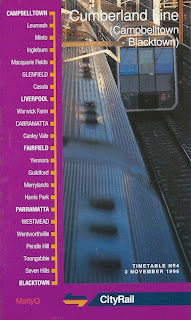Happy birthday Richmond electrification, you turn 21 today! On 17 August 1991, the Riverstone- Richmond section of the Richmond Line saw electric trains introduced. Three 2 car L-sets provided shuttle services between the two stations, providing connections to through trains to the city from Riverstone. A shuttle arrangement was necessary because power supplies were initially inadequate to allow more than one 8-car train north of Riverstone at any one time, surely a strange set of affairs for a new electrification project, however the initial project did not include platform lengthening to a full 8- car length, so the 2 car shuttles simply plodded along to the same timetable as the 2-car diesels that operated previously. The line had been served by fairly dilapidated 2 car 600 class trains, two sets of which were shunted off to the Hunter after their time had finished on the Richmond Line.
The electrification of the Richmond line had a long gestation, with the section to Riverstone electrified in 1975 and seemingly little thought about doing the rest until some masts appeared in the mid 1980's. The newly elected Greiner government in 1988 halted the (slow) work, until work restarted in March 1991, with completion by August. It took another year or so until power supply and platform lengthening allowed 8-car running from Richmond through to the city.
Friday, August 17, 2012
Tuesday, June 12, 2012
Timetable Tuesday- the last RNP trains.
Prior to withdrawal, the Royal National Park (RNP) had only a few daily train patronised by only a handful of hardy souls , presumably bushwalkers happy to make the trek down the hill to Audley and beyond.
The April 1991 timetable shows the following services:
On weekdays, there were 2 morning services. The first service left Bondi Junction (BJ) at 755am arriving at RNP at 846 am. It had a slightly odd stopping pattern, stopping at all stations except Banksia, Carlton, Allawah, Como and Jannali. It left RNP at 904am, stopping all stations to BJ (except Como, Jannali and Oatley). The second service left BJ at 835 am, arriving at RNP at 923am. This one operated express from Sydenham to Hurstville, then all stations to RNP. It turned around for a 931am departure back to BJ stopping all stations.
In the afternoon, there was one service leaving BJ at 215 pm arriving at RNP at 310pm, stopping all stations. This had a quick turnaround departing at 316pm, all to BJ.
On weekends, there were two morning services departing BJ at 755 and 855am arriving at RNP at 847am and 947 am (950am on Sundays and public holidays) respectively,. They departed RNP at 914am and 1014am. In the afternoon there were 2 services departing BJ at 255pm and 3655 pm arriving 347pm and 447pm respectively. They departed RNP at 414pm and 551pm for arrivals at BJ at 508pm and 608pm.
The April 1991 timetable shows the following services:
On weekdays, there were 2 morning services. The first service left Bondi Junction (BJ) at 755am arriving at RNP at 846 am. It had a slightly odd stopping pattern, stopping at all stations except Banksia, Carlton, Allawah, Como and Jannali. It left RNP at 904am, stopping all stations to BJ (except Como, Jannali and Oatley). The second service left BJ at 835 am, arriving at RNP at 923am. This one operated express from Sydenham to Hurstville, then all stations to RNP. It turned around for a 931am departure back to BJ stopping all stations.
In the afternoon, there was one service leaving BJ at 215 pm arriving at RNP at 310pm, stopping all stations. This had a quick turnaround departing at 316pm, all to BJ.
On weekends, there were two morning services departing BJ at 755 and 855am arriving at RNP at 847am and 947 am (950am on Sundays and public holidays) respectively,. They departed RNP at 914am and 1014am. In the afternoon there were 2 services departing BJ at 255pm and 3655 pm arriving 347pm and 447pm respectively. They departed RNP at 414pm and 551pm for arrivals at BJ at 508pm and 608pm.
Monday, June 11, 2012
21 years ago today- last train to Royal National Park
21 years ago today, on 11 June 1991, the final train to the Royal National Park operated without fanfare. Services were abruptly discontinued when a defective signal switch led to the line being inspected and an estimate of $400,000 being required to upgrade the line and track to safe standard. By 1991, the line was carrying only about 100 passengers per week, on weekends only.
After services were withdrawn, CityRail offered a free taxi service (!) between Sutherland and the Royal National Park at the times that the former trains operated.
On 19 June, trains were formally amended in the timetable to terminate at Sutherland on weekdays and Waterfall on weekends.
The line opened in 1886 and was the southern end point of the Illawarra line electrification in 1926. The line lay dormant for a few years after its closure in 1991 prior to tram services from the Sydney Tramway Museum commencing in 1993.
After services were withdrawn, CityRail offered a free taxi service (!) between Sutherland and the Royal National Park at the times that the former trains operated.
On 19 June, trains were formally amended in the timetable to terminate at Sutherland on weekdays and Waterfall on weekends.
The line opened in 1886 and was the southern end point of the Illawarra line electrification in 1926. The line lay dormant for a few years after its closure in 1991 prior to tram services from the Sydney Tramway Museum commencing in 1993.
Tuesday, May 22, 2012
Timetable Tuesday- 1990 Central Coast Line
The counterpart to the 1990 'Newcastle Area' timetable discussed last Tuesday was the 'Central Coast Line' timetable. This timetable combined Northern Line suburban services with services up the Central Coast through to Newcastle, but excluded "local services' between newcastle and Fassifern (and the Toronto branch line). Therefore it carried the note that it didn't show all services between Fassifern and Newcastle)
The basic Central Coast portion of the timetable consisted of hourly 'fast' services between Newcastle and Sydney, with an additional slower hourly 'all stations' service. The express service overtook the preceding all stations service at Gosford, with with a 11 minute (down trains) or a 17 minute (up trains) pause of the slow service at Gosford to allow the pass to occur. This was supplemented by a few weekday peak hour Gosford, Morisset and Wyong starters. Only one morning peak service from Gosford operated via the North Shore, all others operated via Strathfield and terminated at Sydney Terminal. On weekends, the slow interurbans served the stations between Cowan and Berowra. Also Interurbans stopped at Eastwood rather than Epping.
So essentially all stations on the Central Coast line received at least an hourly service on all days. This is a more favourable service compared with todays weekend timetable north of Wyong.
The basic Central Coast portion of the timetable consisted of hourly 'fast' services between Newcastle and Sydney, with an additional slower hourly 'all stations' service. The express service overtook the preceding all stations service at Gosford, with with a 11 minute (down trains) or a 17 minute (up trains) pause of the slow service at Gosford to allow the pass to occur. This was supplemented by a few weekday peak hour Gosford, Morisset and Wyong starters. Only one morning peak service from Gosford operated via the North Shore, all others operated via Strathfield and terminated at Sydney Terminal. On weekends, the slow interurbans served the stations between Cowan and Berowra. Also Interurbans stopped at Eastwood rather than Epping.
So essentially all stations on the Central Coast line received at least an hourly service on all days. This is a more favourable service compared with todays weekend timetable north of Wyong.
Weekday example:
Weekend example:
The suburban portion detailed services between Hornsby and Central via Strathfield The present 'Northern Line'. Suburbans generally started at Hornsby with about a 15 minute frequency in peak hours consisting of a mixture of all stations and limited stoppers, and a half hourly frequency off peak and weekends. A mixed bag of mainly peak hour additional services started or terminated at Epping. Suburbans between Berowra and Hornsby operated via the North Shore, and were shown in the timetable with the annotation 'via North Shore'.
Labels:
Central Coast Line,
history,
Newcastle Line,
Northern Line,
timetable
Monday, May 21, 2012
Monday maps- Interurban 1980s
This map is from the mid 1980s. Electrification must end at Wyee, but not sure why it cuts off Kiama- Bomaderry.
Tuesday, May 15, 2012
Timetable Tuesday: 1989- Newcastle Area
In 1990, the Toronto branch line in the Newcastle area closed. The Toronto line was a single track line which branched from the Main North at Fassifern, and served the lakeside town of Toronto, with one intermediate station- Blackall's Park. Toronto station still exists, reasonably well preserved.
The October 1989 timetable is the last timetable which included this line. The running time for the branch was 6 minutes, and remarkably an approximately 20 minute frequency was maintained on the line, even on weekends. Every 2nd or so train connected with services to Newcastle or Sydney.
The timetable was also formatted in such a way that the some Toronto branch services appear in the same column as the main line service (you will see what I mean in the examples of the timetable).
This was also the last CityRail timetable to feature the Brisbane Limited and the Pacific Coast Moto-rail prior to their replacement by XPTs.
Also, Hilldale and Wirragulla stations were not served, and CityRail services ended at Muswellbrook (i.e. they didn't make it to Scone). There were the same number of weekday services past Telarah as today- 4 to Muswellbrook and 5 to Dungog. Weekend frequency was the same as today but different timings.
The frequency of services between Telarah and Newcastle was about the same as today, but in 1989 services stopped at all stations giving a half hour frequency for all intermediate stations, compared to an hourly frequency at smaller stations today with the current pattern of alternate limited stops services.
Note also that the map has a gap between Singleton and Branxton. I'm not sure what station was previously there. Belford was served for a while after 1990, but there are a couple of other possibilities: Whiitingham?, Minimbah? Warabrook and Metford hadn't opened then either- they debuted in 1995.
The October 1989 timetable is the last timetable which included this line. The running time for the branch was 6 minutes, and remarkably an approximately 20 minute frequency was maintained on the line, even on weekends. Every 2nd or so train connected with services to Newcastle or Sydney.
The timetable was also formatted in such a way that the some Toronto branch services appear in the same column as the main line service (you will see what I mean in the examples of the timetable).
This was also the last CityRail timetable to feature the Brisbane Limited and the Pacific Coast Moto-rail prior to their replacement by XPTs.
Also, Hilldale and Wirragulla stations were not served, and CityRail services ended at Muswellbrook (i.e. they didn't make it to Scone). There were the same number of weekday services past Telarah as today- 4 to Muswellbrook and 5 to Dungog. Weekend frequency was the same as today but different timings.
The frequency of services between Telarah and Newcastle was about the same as today, but in 1989 services stopped at all stations giving a half hour frequency for all intermediate stations, compared to an hourly frequency at smaller stations today with the current pattern of alternate limited stops services.
Note also that the map has a gap between Singleton and Branxton. I'm not sure what station was previously there. Belford was served for a while after 1990, but there are a couple of other possibilities: Whiitingham?, Minimbah? Warabrook and Metford hadn't opened then either- they debuted in 1995.
Monday, May 14, 2012
Friday, May 11, 2012
The East Hills Timetables part 3- Glenfield extension 1987
In 1987, the extension between East Hills and Glenfield on the Main South line opened. It was soft opening to a degree, in that services operated along the extension only during weekday peak hours initially. The timetable was essentially the same as pre opening, with some tweaking to accommodate the new services. 3 services traversed the extension in the morning, with 3 retuning in the afternoon. There were no services on Sundays or public holidays.
Sorry that my copy of the timetable is a bit tatty. For some reason I can't upload the cover, will try again later.
Thursday, May 10, 2012
Tuesday, May 8, 2012
20 years ago- the 1992 CityRail timetable
In January 1992, CityRail introduced a new timetable. The timetable was the most significant alteration to suburban and intercity working for some time, and was not without controversy.
The goals of the timetable were to provide a better service from outer suburban areas to the city, at some expense to inner suburbs and a reduction in pre peak hour services in the mornings. Secondly, the timetable introduced a reduction in single deck "red rattler" services with their confinement to the Inner West and Bankstown line services prior to their complete withdrawal shortly after. 8-car length single deck trains were discontinued, with the only single deck cars left being those matched with double deck Tulloch trailers in W-sets.
The Richmond line, which was fully electrified the year before, saw the first through-running of services between Richmond and the city (initially only 4 cars trains until the power supply was upgraded later in the year to support 8-car trains). The two car L Sets that operated Richmond- Riverstone shuttles were replaced with 4-cars sets.
Other features of the new timetable were:
- Cowan was no longer the northern boundary of suburban services, with Northern line services terminating one station south at Berowra
- Sandown line services officially withdrawn (they actually stopped running in December 1991).
- the withdrawal of most through Southern Highlands services to Central, most services now operated as shuttles south of Campbelltown in a similar manner to today
- withdrawal of Kingsgrove as a terminating location for trains, not to be reinstated until quadruplication was completed
- withdrawal of Chatswood as a train terminating location
- cancellation of local 2-car Newcastle- Fassifern services
- reduction of single deck U-sets from most Central Coast / Newcastle services
- loss of the separate Saturday and Sunday timetables , now grouped together as 'Weekends'
- reduction in weekend Eastern Suburbs line frequency from 10 to 15 minutes.
- a 10% reduction in the number of train sets needed to operate the timetable.
CountryLink timetables were also modified but there were only timing changes.
The physical timetables had a newer look, with glossy full colour covers and a new map on the reverse. Below is the Campbelltown via Liverpool line as an example.
The actual timetable itself was in a similar layout to previously.
The goals of the timetable were to provide a better service from outer suburban areas to the city, at some expense to inner suburbs and a reduction in pre peak hour services in the mornings. Secondly, the timetable introduced a reduction in single deck "red rattler" services with their confinement to the Inner West and Bankstown line services prior to their complete withdrawal shortly after. 8-car length single deck trains were discontinued, with the only single deck cars left being those matched with double deck Tulloch trailers in W-sets.
The Richmond line, which was fully electrified the year before, saw the first through-running of services between Richmond and the city (initially only 4 cars trains until the power supply was upgraded later in the year to support 8-car trains). The two car L Sets that operated Richmond- Riverstone shuttles were replaced with 4-cars sets.
Other features of the new timetable were:
- Cowan was no longer the northern boundary of suburban services, with Northern line services terminating one station south at Berowra
- Sandown line services officially withdrawn (they actually stopped running in December 1991).
- the withdrawal of most through Southern Highlands services to Central, most services now operated as shuttles south of Campbelltown in a similar manner to today
- withdrawal of Kingsgrove as a terminating location for trains, not to be reinstated until quadruplication was completed
- withdrawal of Chatswood as a train terminating location
- cancellation of local 2-car Newcastle- Fassifern services
- reduction of single deck U-sets from most Central Coast / Newcastle services
- loss of the separate Saturday and Sunday timetables , now grouped together as 'Weekends'
- reduction in weekend Eastern Suburbs line frequency from 10 to 15 minutes.
- a 10% reduction in the number of train sets needed to operate the timetable.
CountryLink timetables were also modified but there were only timing changes.
The physical timetables had a newer look, with glossy full colour covers and a new map on the reverse. Below is the Campbelltown via Liverpool line as an example.
Note that the map has lost the Royal National Park and Sandown branches.
In the middle of the timetable was a further pair of glossy pages, with a guide to station facilities in the middle, and some passenger info on the reverse.
Monday, May 7, 2012
Monday maps- the original Nightride map
Nightride was introduced in 1989 as a bus service to replace late night / early morning train services. The publicised rationale was to free up tracks for maintenance etc, hover the real reasons were cost savings and to save the trains from vomit, graffiti and other damage.
Here is the map of the original services. The current map is below for comparison.
Here is the map of the original services. The current map is below for comparison.
Monday, February 20, 2012
Monday maps- Clearways
Here is a map of what the CityRail network might look like post-clearways, with the commissioning of the Kingsgrove- Revesby Quad, and the Lidcombe and Homebush turn-backs.
Monday, February 13, 2012
Monday maps- Railways of Australia
Here is an unusual map from 'Railways of Australis', a marketing collaboration of all the State Government- owned country passenger rail services, from the 1980s.
Monday, February 6, 2012
Monday maps- 1996 CityRail map
In 1996, The Cumberland Line opened. A new map was commissioned, with the new line of course, but also some other additions. The under-construction Airport line is added, as is a fairly poor attempt at representing the light rail line, then being built as far as Wentworth Park but marked as going to Pyrmont on the map. Note also the angle of the Carlingford line towards the Northern line to accommodate the proposed Chatswood- Parramatta line, and a gap between stations on the Western line to accommodate a proposed Nepean University station. Also Wolli Creek is marked as North Arncliffe.
All up, an improvement on the 1989 map.
All up, an improvement on the 1989 map.
Tuesday, January 31, 2012
Timetable Tuesday- 1996 Cumberland line 2
As promised last week, here is the timetable.
Weekdays southbound.
Weekdays northbound
Weekdays southbound.
Weekdays northbound
Weekends southbound
Weekends northbound
Monday, January 30, 2012
Monday maps- first CityRail map
When CityRail was formed in 1989, a new map shortly followed. Here is the full network map, with the suburban network as a cutout. I hate it, microscopic text, ambiguous junctions, the bus services aren't diagrammatically represented.....
It wasn't to change until the Cumberland line opened in 1996.
Thursday, January 26, 2012
Mortdale Maintenance Centre
A decade or so ago, CityRail hosted open days at it's depots. Here is a brochure picked up at one of them providing information about Mortdale maintenance centre. A V set is up on the hoist, despite being maintained at Flemington.
Tuesday, January 24, 2012
Timetable Tuesday- 1996 Cumberland line
In 1996, the 'Y Link' between Merrylands and Harris Park opened and the Cumberland Line was born. And a proper service it was too, not just the present few services a day. Here is the inaugural timetable. The cover and information pages are below, I'll post the actual timetable soon.
Monday, January 23, 2012
Saturday, January 21, 2012
Tangara- 21st Century travel years ahead of its time
It won't be long before the first of the Tangaras are 30 years old. With the arrival of the Waratah trains, its interesting to reflect on the promotion of the Tangaras when they were about to be introduced, in particular the championing of the Australian made components. A contrast to today when the partially Chinese built Waratahs are almost embarrassingly slipped into service.
A word from our leader (the other Barry)....
The mockup, note the desto....
Some bits ended up looking a bit different....
Companies were proud to be associated- BHP, Mitsubishi Electric Australia and of course Goninan.
Heres a pic of the stainless steel construction....
And finally propaganda from the government on how well they are doing, note the Maldon-Dombarton line.
Subscribe to:
Comments (Atom)








































